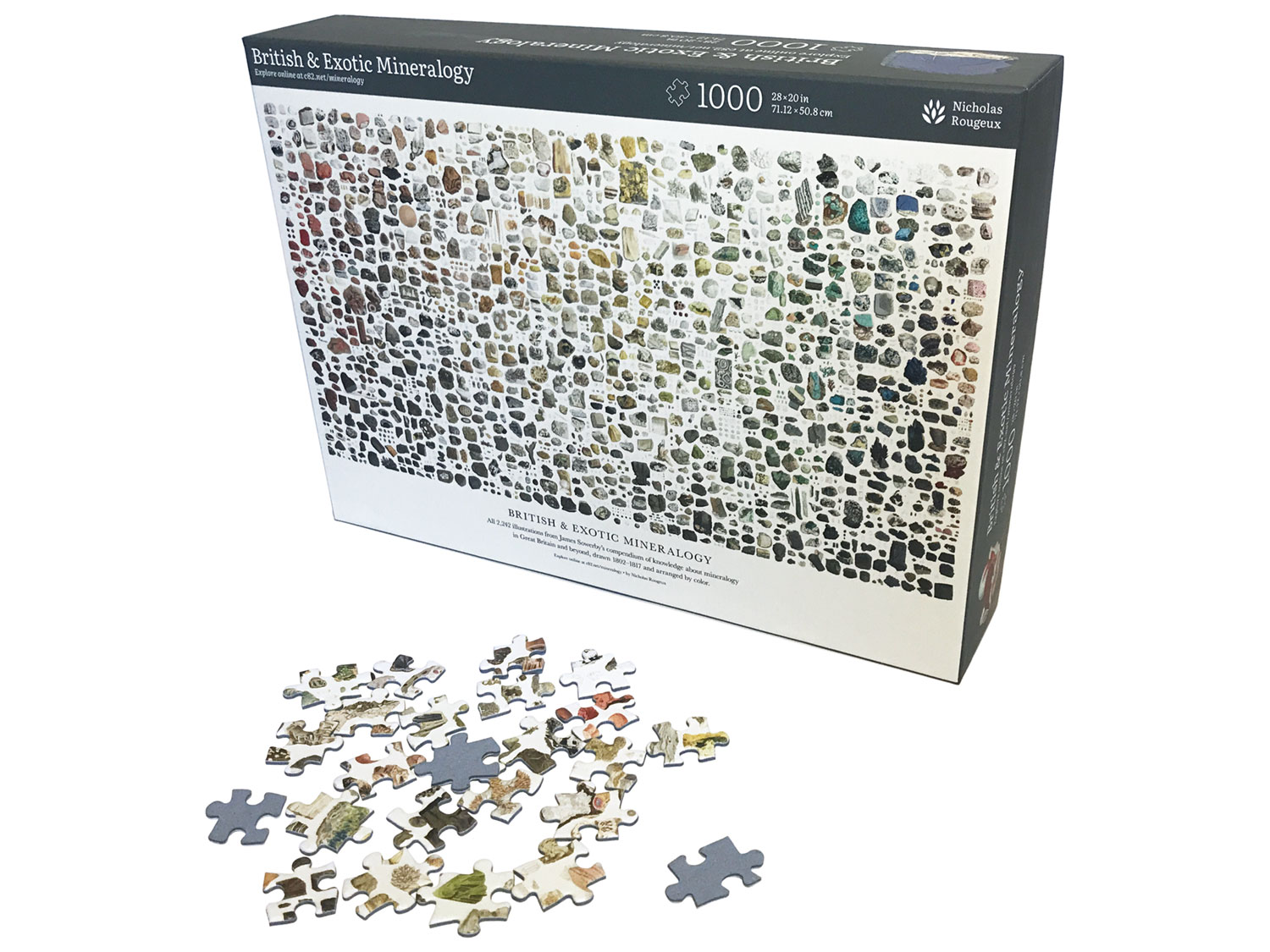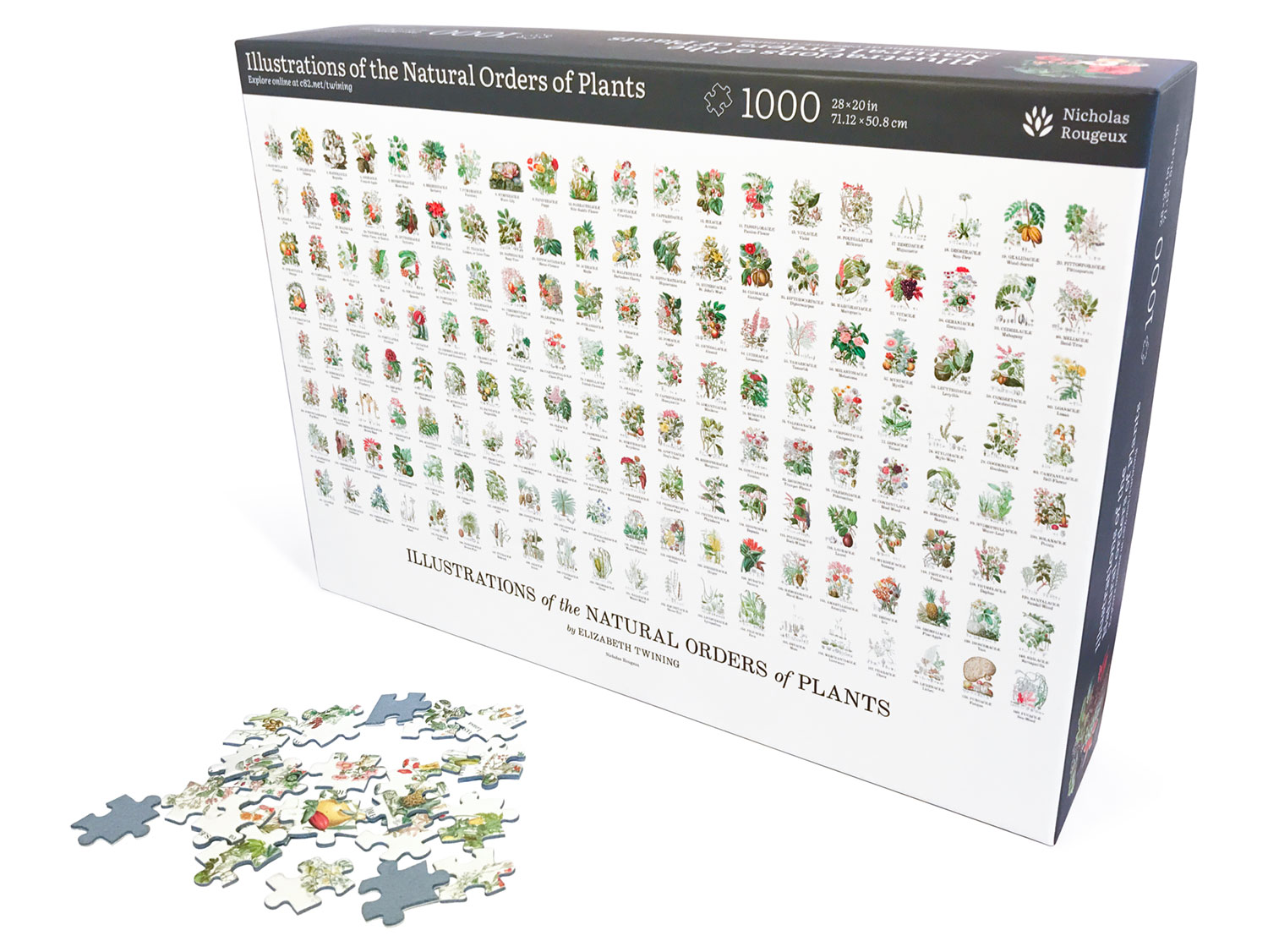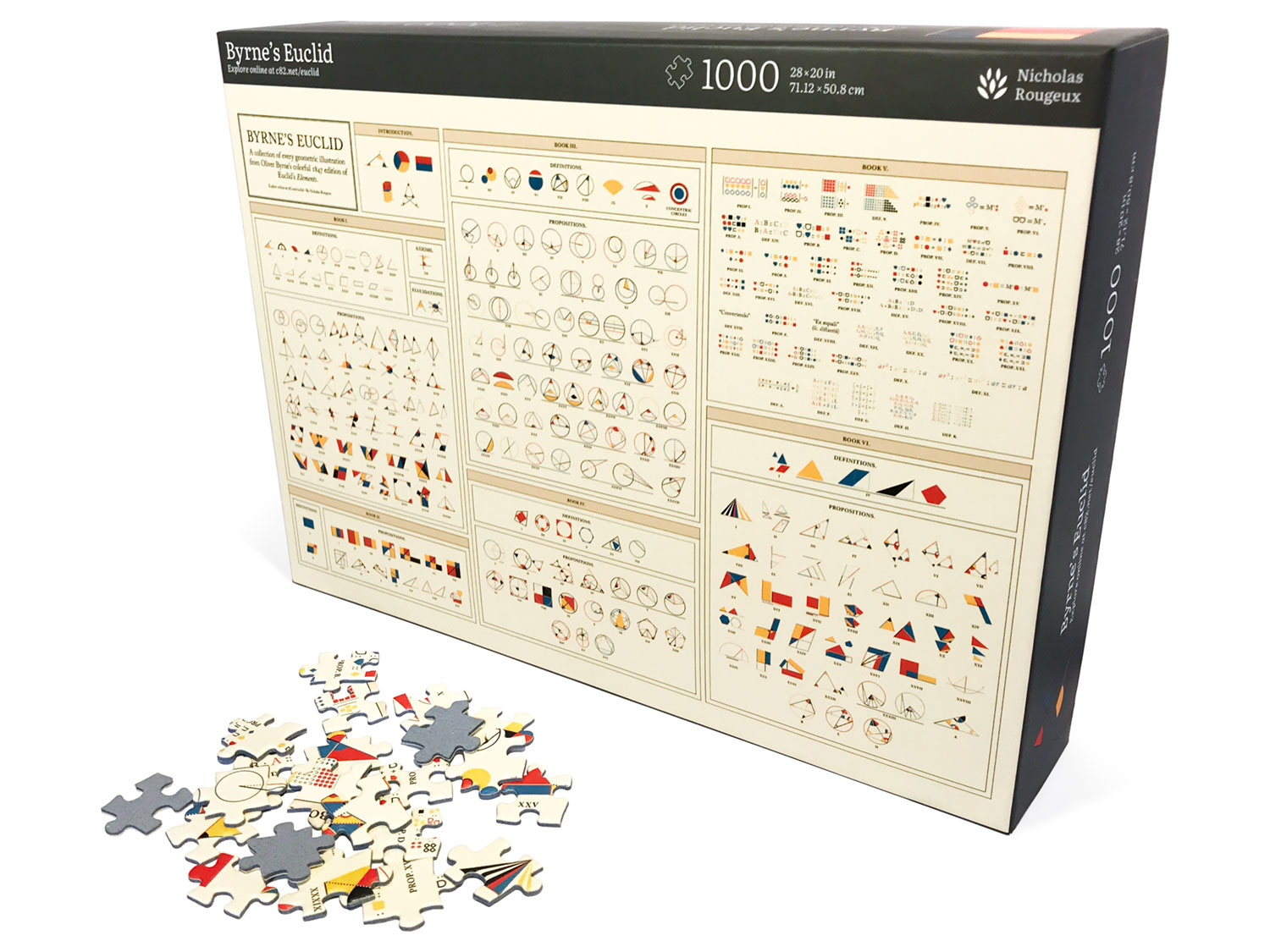Announcing jigsaw puzzles
By Nicholas Rougeux, posted on October 29, 2020 in Art
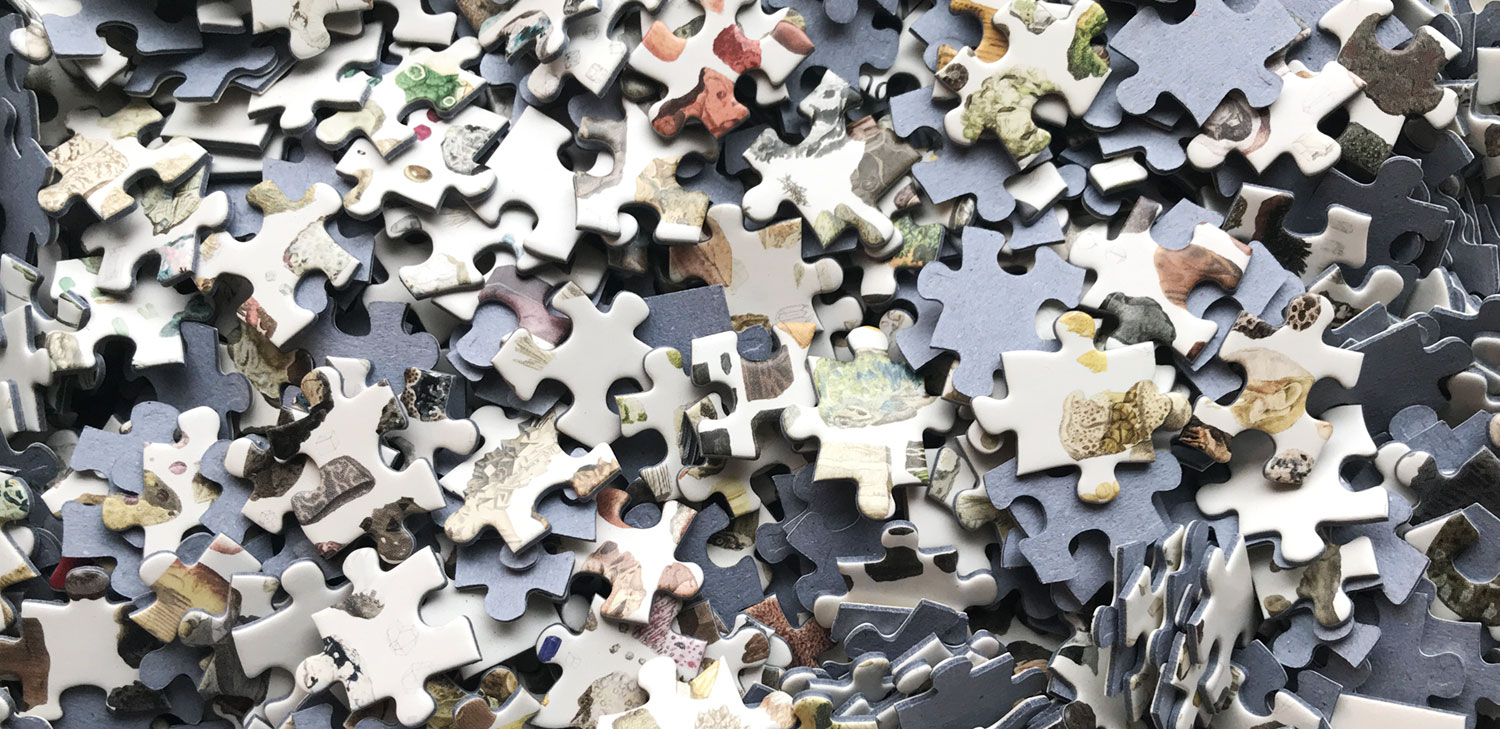
I’m excited to announce that 1,000-piece jigsaw puzzles are now available for three of my projects with more to come. Puzzles are available for British & Exotic Mineralogy, Illustrations of the Natural Orders of Plants, and Byrne’s Euclid. Each one presents its own challenges unique to its design and they’re really fun to put together.
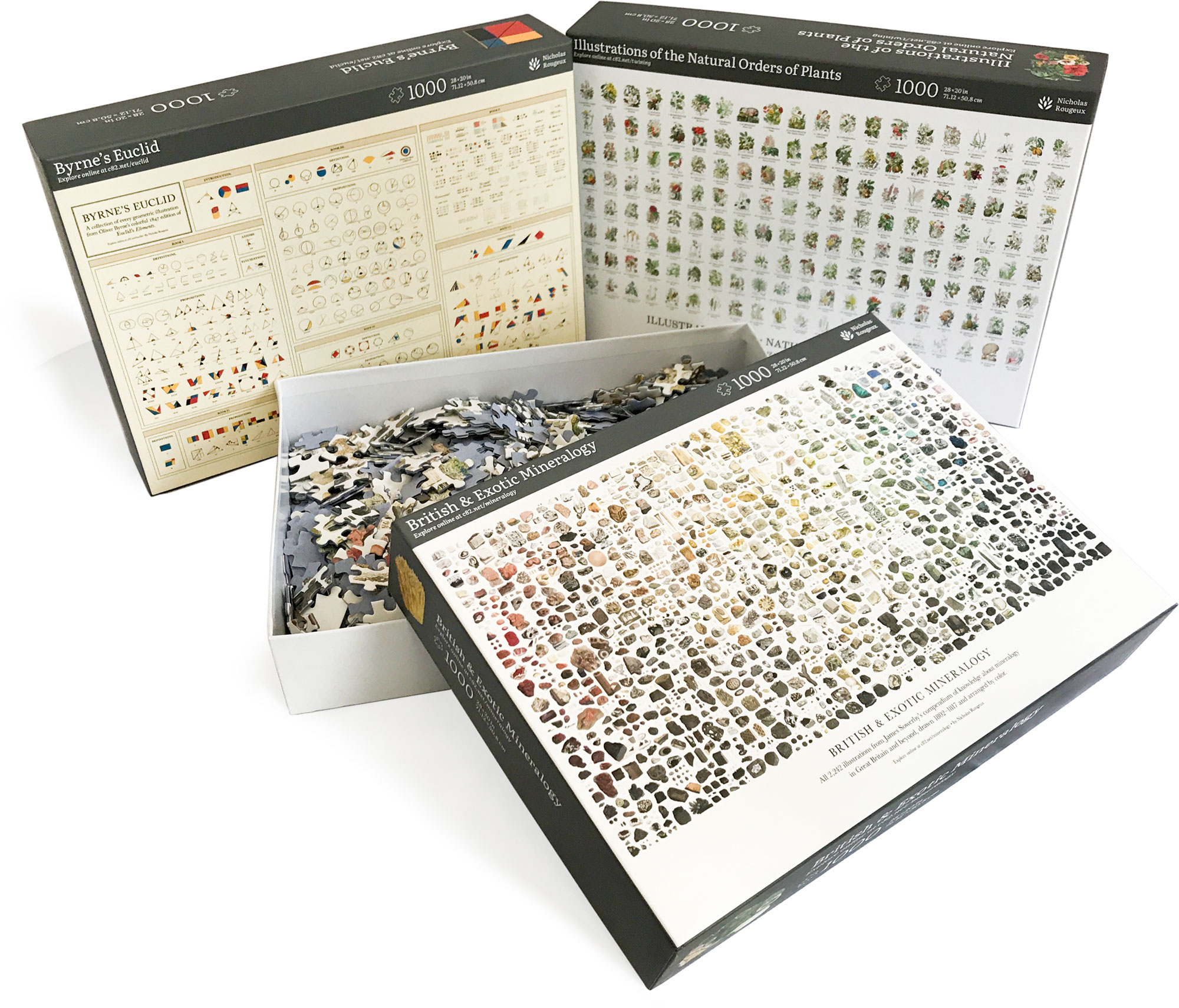
Making jigsaw puzzles
The idea to offer puzzles was sparked by some recent comments that the mineralogy poster could be a good fit. That started me down an intriguing path of researching what it would take to get these puzzles manufactured. I had two goals from different perspectives: as a puzzler, I wanted to have a fun high-quality puzzle to put together and as a designer, I wanted to be able to offer puzzles online without jumping through too many hoops (licensing, manufacturing, contracts, etc).
Before I could make any puzzles available for everyone, I needed to try them out myself so I could stand behind what I'm offering. I sought out vendors that manufacture puzzles on demand and chose three to evaluate: Zazzle, Redbubble, and Create Jigsaw Puzzles. Each vendor’s puzzle differs slightly in terms of material, quality, etc. which can greatly affect the assembling experience.

Disclaimer: I’ve sold posters from Zazzle for many years which is why they were one of the vendors chosen for this research. As part of my research, I requested a complimentary puzzle to try out and they were kind enough to provide me with one but this did not bias my evaluation.
Qualities of a good puzzle
When I was young, I used to put together many 3D foam puzzles and only a handful of the traditional cardboard puzzles. As I got older, I lost interest but remembered the satisfaction of completing a puzzle and even just finding two pieces that fit together. A surprising number of factors make up a quality puzzle that leads to that satisfaction:
- Design: A traditional jigsaw puzzle is only as good as the image it depicts and a good puzzle should be based on an image with a lot of unique detail to encourage exploration. I chose three of my more popular collages of minerals, geometry, and botany which offer variety of unique details—each presenting their own challenges.
- Box: The image on the box should be as large and clear as possible on the box or made available as a separate printed piece of paper for reference. The box itself should be sturdy enough to withstand being moved around repeatedly while the puzzle is assembled or stored for long periods of time.
- Image quality: The image printed on the pieces should be as clear as possible with no bleeding or smudging to allow for close examination while they’re assembled.
- Material: Pieces should be sturdy, not bendable, and thick enough to easily manipulate. The image printed on them should not peel off. Pieces can be either glossy or matte finish as long as it doesn’t impact the printed quality of the image.
- Fit: Pieces should fit tightly together and only fit with the correct pieces. Pieces that don’t go together shouldn’t fit together. Ideally, multiple pieces assembled into a section could be lifted at once.
- Dust: Some “puzzle dust” is normal after pieces are cut but there shouldn’t be so much to make a messy work surface.
Reviews
I ordered a puzzle of my British & Exotic Mineralogy collage from each vendor to compare each of the factors above. Each puzzle had 1,000 pieces and was about 30 × 20 inches. I felt this was enough pieces to last a while and large enough to explore the details.
Before getting into the details, it’s important to note that I’m evaluating these vendors’ puzzles based on slightly unusual material. All vendors produce excellent puzzles for causal custom puzzles like family pictures or promotional materials. My evaluation is based on a very detailed collage of my own making so I looked at them with a more critical eye than I would if I was ordering something with less detail for a fun family gathering or company promotion.
Let’s dig into each one of these, starting with the boxes.
Boxes
The box is a puzzle’s first impression and sets expectations for what someone will be staring at for many hours while assembling the puzzle. I was most curious about what the boxes would look like because none of the vendors offered detailed enough previews on their website (if any) for me to get a good idea of what they would be like.
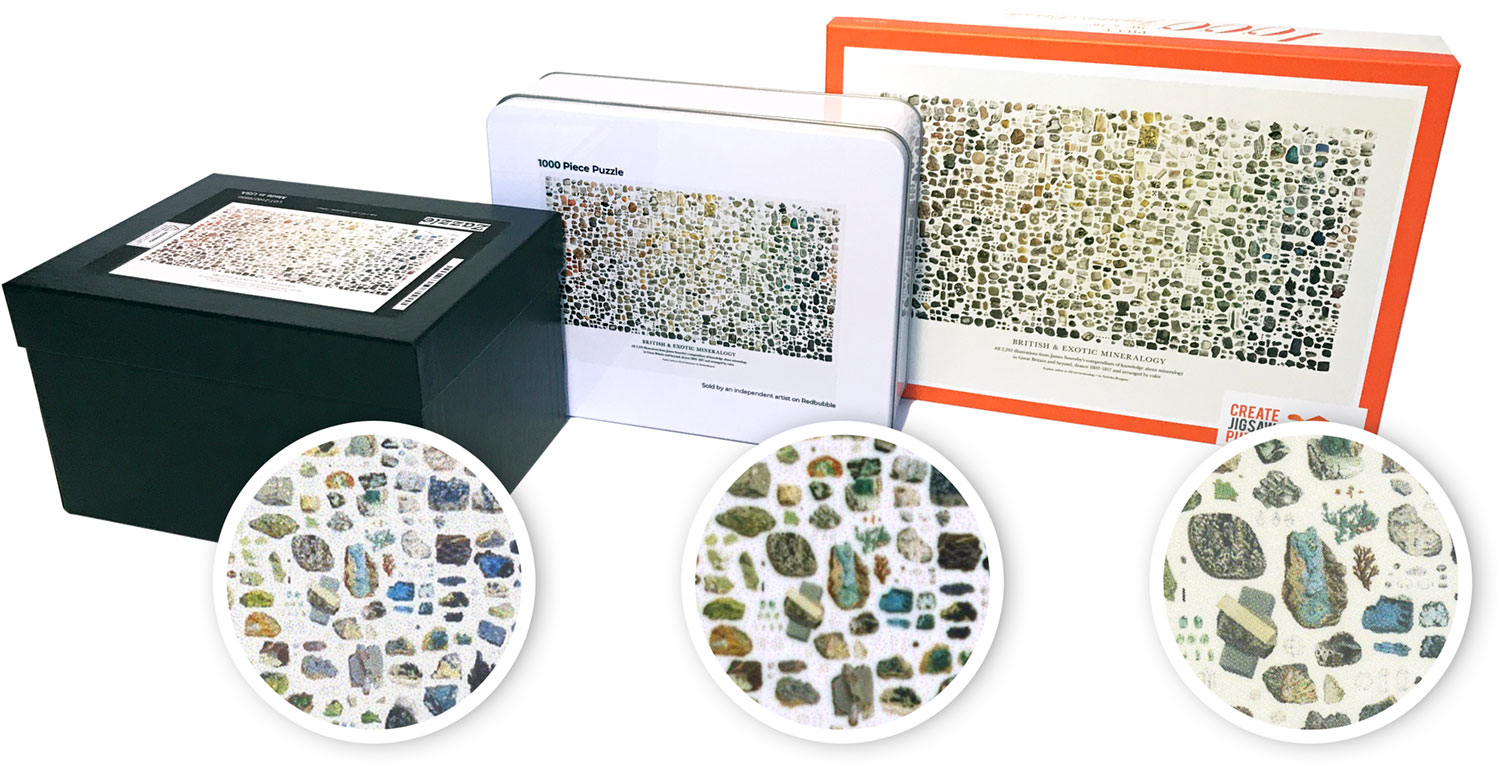
Left to right: Zazzle, Redbubble, Create Jigsaw Puzzles
Zazzle: Okay
Zazzle’s box was built out of very sturdy cardboard and came with a nice black covering. However, it was quit small at 7.5 × 5.25 × 4.5 inches. Because of this, the image printed on the lid was far too small to be useful at 5 × 3.25 inches so I used my own website with a zoomable collage as a reference instead of Zazzle’s box. The small box also meant I couldn’t use it as a sorting tray and had to lay all the pieces out on a table to sift through them.
Redbubble: Okay
Redubble’s box was tin instead of the classic cardboard. The tin was nice in and of itself but it had the same drawbacks as Zazzle’s box: the image on the lid far too small and even less detail, even though it was slightly larger. Redbubble’s box was 8 × 6.5 inches and the picture on the lid was 5.875 × 4 inches.
Create Jigsaw Puzzles: Great
Create Jigsaw Puzzles’ box was a significant improvement compared to the others. The box was a more standard shorter but wider shape at 10.75 × 7.75 × 2 inches which meant both the lid and the base were large enough to use as small sorting trays. The image printed on the box was excellent and showed a lot of great detail—enough to be used as a guide during assembly. It was also made from a very sturdy cardboard with an almost satin-like coating. The box I ordered was their standard design with an orange border but they allow for custom designs to be submitted for the entire lid, including the sides.
Image quality
The image printed on the puzzles from all three vendors was good but there were slight differences that had a large impact on the overall quality.
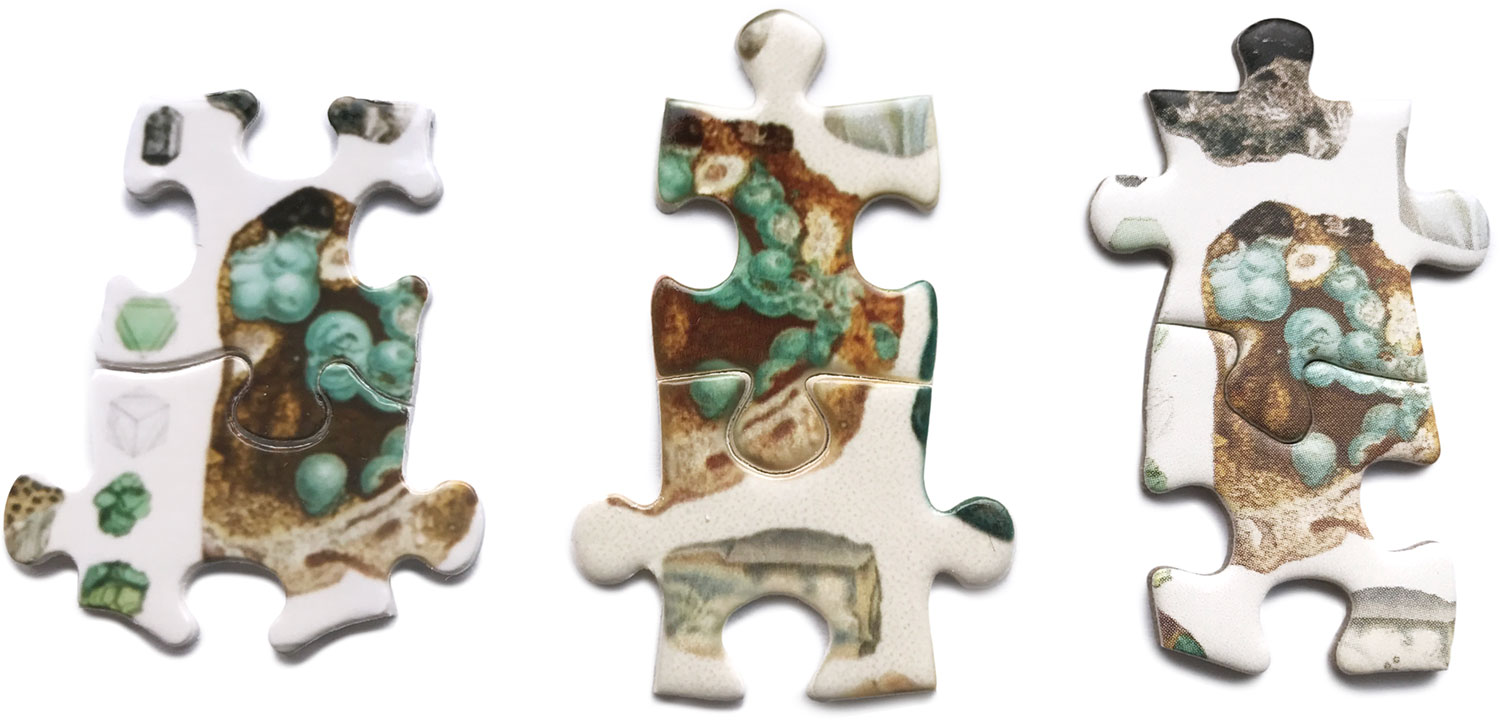
Left to right: Zazzle, Redbubble, Create Jigsaw Puzzles
Zazzle: Okay
Zazzle used a printing process that retained a lot of quality when viewed from a distance but but upon closer examination, the finer details were a little blurry—almost as if the ink didn’t try fast enough before the details blended with each other. The image was also inexplicably printed off-center so there was more whitespace on one side than the other for the final assembled puzzle.
Redbubble: Poor
Redbubble retained a lot of detail but suffered a little from the same blurriness as Zazzle. Many tiny dots appeared as part of the background which should have been a solid color. This may be a limitation of their printing method but they were somewhat distracting. Redbubble’s pieces also suffered from bleeding or running colors around many edge pieces, which made finding pieces that fit more difficult. The colors also turned out warmer than the others so greyer colors appeared more red/orange which made using a box or my online companion harder than it should have been.
Create Jigsaw Puzzles: Great
Unlike the other vendors, Create Jigsaw Puzzles appears to use halftone printing which didn’t create the same blurriness and in fact, gave the appearance of even more detail than I thought was possible. The image was very clear and there was no bleeding around the edges. The pieces could be examined very closely for examining the tiny details.
Material
Puzzles come in a variety of materials like cardboard, wood, acrylic, glass, and more but I chose to get the traditional cardboard from all three vendors.
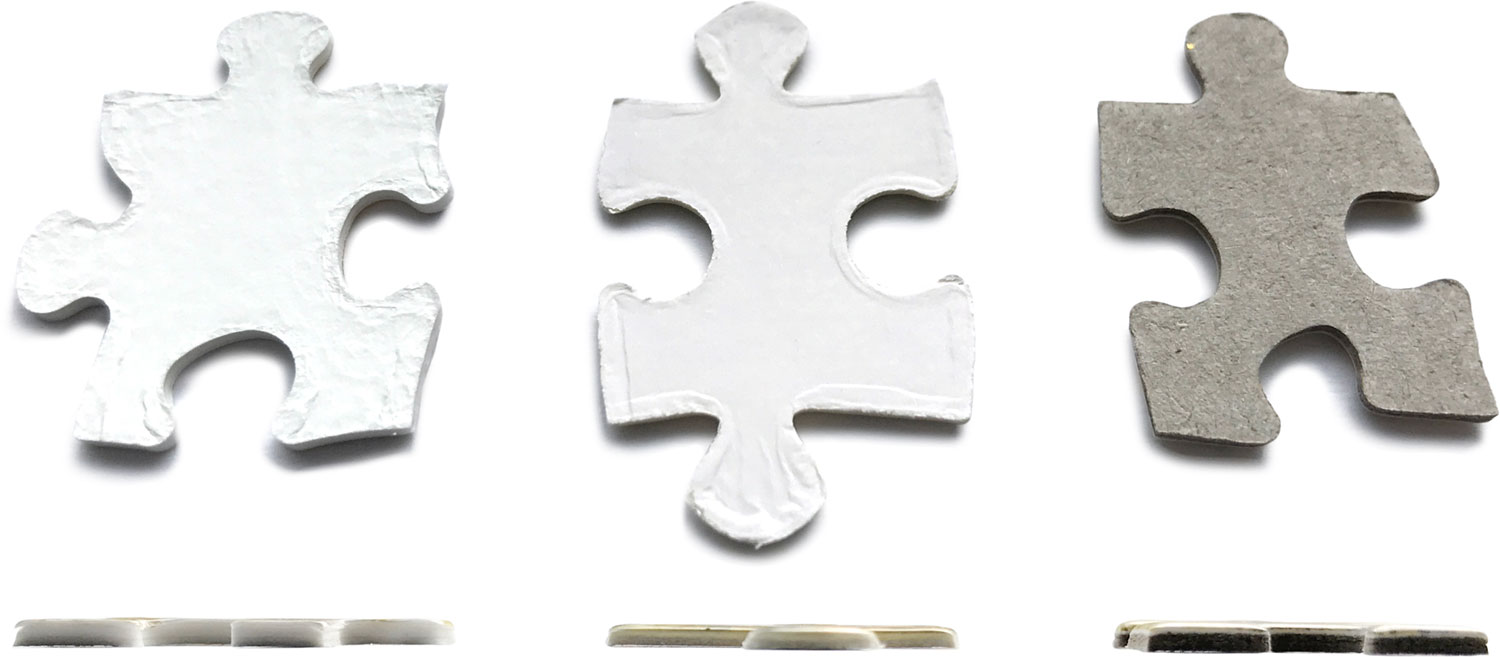
Left to right: Zazzle, Redbubble, Create Jigsaw Puzzles
Zazzle: Great
Zazzle’s pieces were made from some kind of very strong cardboard that at first glance, almost felt like plastic. They felt like the strongest of the three vendors’ offerings. However, they were very glossy and caught every reflection which made assembly a little challenging. The backing was the second thickest cardboard with a glossy coating. The paper on which the image was printed didn’t show any sign of peeling, even after a lot of use.
Redbubble: Poor
Redbubble’s pieces were printed on thin chipboard and several pieces were already bent when I opened the box. Several pieces also showed signs of peeling paper that the image was printed on. The pieces were very thin which made them difficult to manipulate and separate from each other. The image was printed on glossy paper which caught all the reflection. Their thinness and light weight even caused some to stick together due to static cling. Sorting through pieces was difficult because they couldn’t easily be moved around on a table without overlapping each other or catching on clothing. The pieces also had an odd faint smell that was a little off-putting.
Create Jigsaw Puzzles: Great
Create Jigsaw Puzzles offers a choice of materials and even a choice of the type of cardboard (professional or ESKA). The first test puzzle I ordered from them was made from the professional cardboard and that was excellent. It was thick, sturdy, and the image printed on the pieces never peeled. I had the choice of glossy or matte finish and chose matte and found that it made the assembly process much less distracting without losing any quality. Their pieces also had the more classic slight pillow shape which made the pieces satisfyingly slide into place.
Fit
How well pieces fit together is crucial for a puzzle and finding that sweet spot of making the pieces fit together so satisfyingly is a daunting challenge.
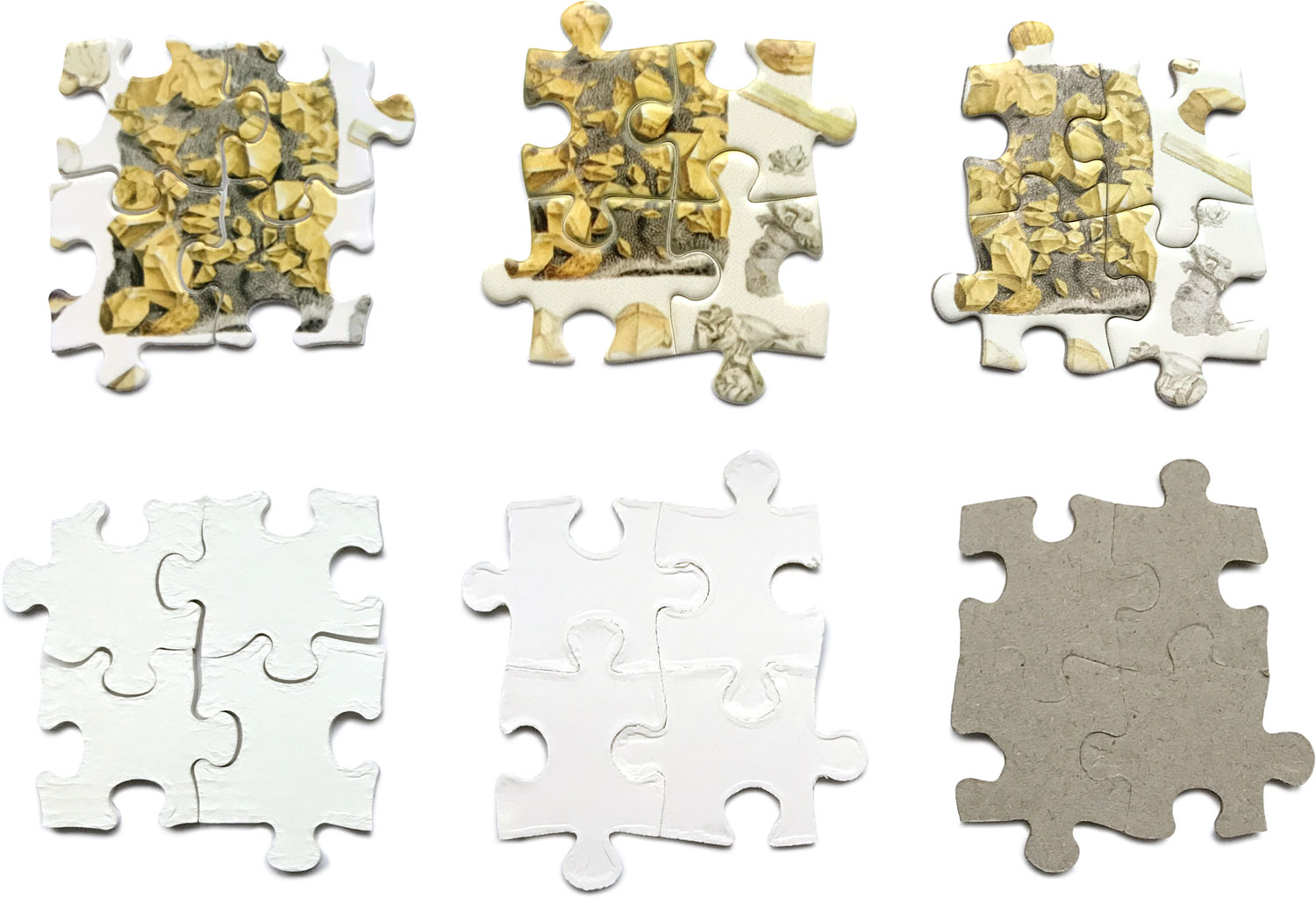
Left to right: Zazzle, Redbubble, Create Jigsaw Puzzles
Zazzle: Poor
Zazzle’s pieces fit together very loosely—so much so that trying to pick up more than one piece at a time wasn’t possible and moving larger sections around very challenging. Throughout assembly, I could easily create tiny gaps between assembled pieces as I moved them around. I was able to make the entire puzzle a few millimeters larger by the end by shifting it around. However, there was very little ambiguity about which pieces went together so there were few mismatches. There was enough variety in the shapes of the pieces that finding the right fit was a good but not overwhelming challenge.
Redbubble: Okay
Redbubble’s pieces fit together tightly but their thinness prevented them from staying together. Their shapes didn’t have enough variety so it was easy to fit wrong pieces together which made pieces that were all one color a significant challenge to match. I was constantly second-guessing my decisions about which pieces fit together. Apart from the edges, Redbubble’s pieces were all the same shape with subtle variations while Zazzle and Create Jigsaw Puzzles used more variety.
Create Jigsaw Puzzles: Great
The pieces from Create Jigsaw Puzzles fit together very well. They weren’t too loose and could be just a little tighter to facilitate lifting multiple pieces at once, but this wasn’t a showstopper. The slight pillow shape around the edges made fitting filling small gaps and corners very fun and satisfying. There was plenty of variety to the standard piece shapes which meant that there was rarely a mismatch. The pieces fit together very smoothly.
Puzzle dust
I didn’t think puzzle dust was even a factor to consider until I learned the amusing but accurate term. Puzzle dust is the fine shavings left over from when a puzzle is cut and bagged during production. It’s a normal occurrence but can make for a messy workspace if there’s too much.
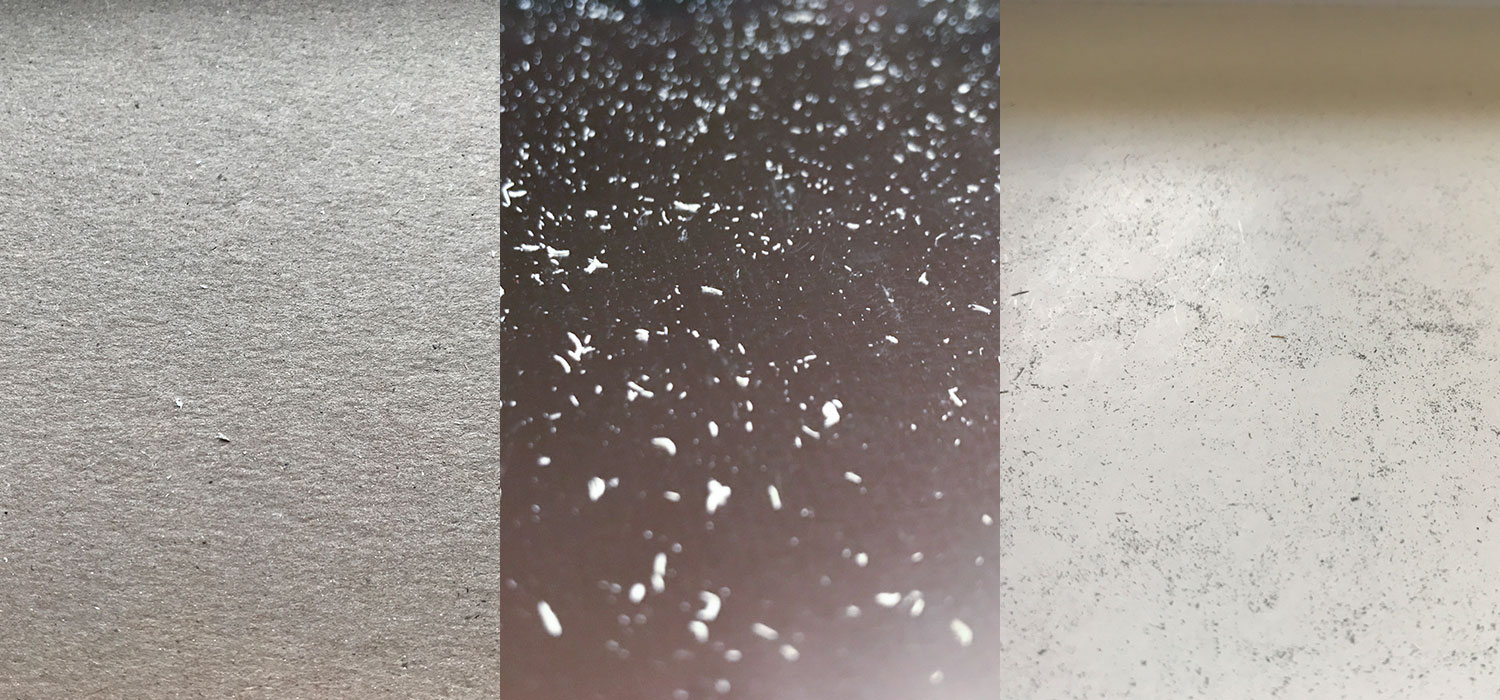
Left to right: Zazzle, Redbubble, Create Jigsaw Puzzles
Zazzle: Great
Zazzle impressively had almost no dust at all. I was impressed by how clean their pieces were and the complete lack of cleanup needed as I assembled the puzzle.
Redbubble: Poor
Redbubble had a lot of white dust (even small chunks) that got everywhere. I assembled the puzzle on a dark table and was constantly wiping the dust away.
Create Jigsaw Puzzles: Great
There was a small amount of extremely fine dust from Create Jigsaw Puzzles. Not as little as Zazzle but not nearly as much as Redbubble. It never got in the way and I was able to dispose of most of if after doing the initial sort to find edges. No additional cleanup was needed during assembly.
Cost
Printing anything custom on demand is always more expensive. Most places that sell traditional jigsaw puzzles sell them for $10–$20 because they are manufactured in bulk with varying levels of quality and sell frequently. Custom requires more materials and the ability to manufacture anything at a moment's notice.
I don’t have the luxury of keeping a large inventory of puzzles and I wanted to make sure everyone who orders on gets a great high-quality puzzle so I chose the on-demand route. The cost is higher than your average puzzle but the result is a wonderful puzzling experience. I know because I put together each puzzle I sell to make sure.
Zazzle
Zazzle’s 1,000-piece cardboard puzzles cost $60–$70 on average plus tax/shipping. In my opinion, that’s too high considering the drawbacks like a small box image and loose-fitting pieces.
Redbubble
Redbubble’s 1,000-piece puzzles cost around $30–$40 on average plus tax/shipping. That’s the low end of the spectrum between the three vendors reviewed here even though it’s high compared to your average puzzle purchased elsewhere. However, with that lower price also comes a lower quality and not worth the cost.
Create Jigsaw Puzzles
Puzzles created on Create Jigsaw Puzzles with the high quality options like a matte finish, ESKA puzzle board, and custom designed box cost $69 plus tax/shipping with discounts for ordering multiple puzzles. Their shipping can also be on the high end. However, I feel the extra cost is worth it considering the impressive quality they produce and the pleasant experience that comes from assembling their puzzles.
Final results
Below is a summary of how they turned out.
| Criteria | Zazzle | Redbubble | Create Jigsaw Puzzles |
|---|---|---|---|
| Box | Okay | Okay | Great |
| Image quality | Okay | Poor | Great |
| Material | Great | Poor | Great |
| Fit | Poor | Okay | Great |
| Puzzle dust | Great | Poor | Great |
| Cost | $60–$70 | $30–$40 | $69 |
Zazzle’s puzzle was the runner up. It’s probably better suited for puzzles with fewer pieces and less detail, the small box and loose pieces kept it from being my top choice. If those were improved, I'd be much more likely to recommend it.
Redbubble’s puzzle needs a lot of improvement. It’s not a good value for the price and is probably best for smaller puzzles. Thin pieces and ambiguous fitting makes it frustrating to assemble.
The clear winner in this comparison was Create Jigsaw Puzzles. I enjoyed everything about their puzzles from creating my own box design to playing with the pieces and admiring the final assembled puzzles.
Order today
High quality puzzles for British & Exotic Mineralogy, Illustrations of the Natural Orders of Plants, and Byrne’s Euclid are now available from Create Jigsaw Puzzles. They make great gifts or fun distractions while we’re all isolating ourselves. Order one of each and get a discount automatically. I’m probably a little more excited about it because I made the designs but I had a great time creating them and I think you will too.

